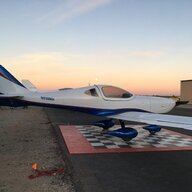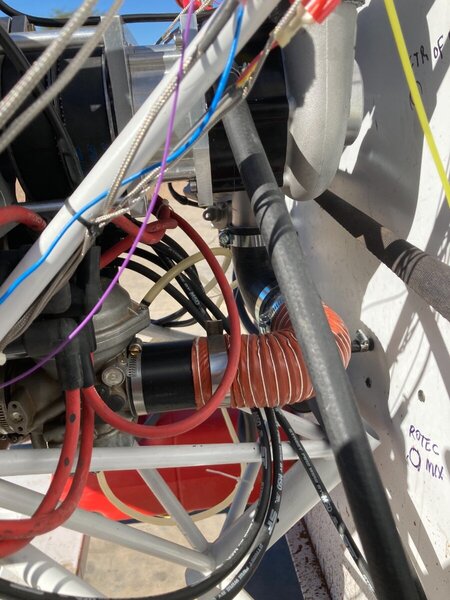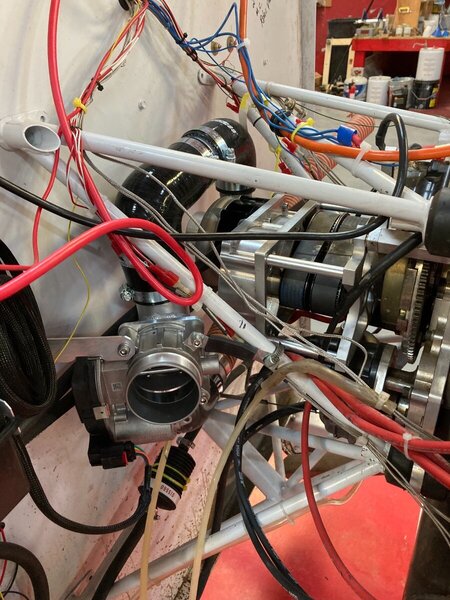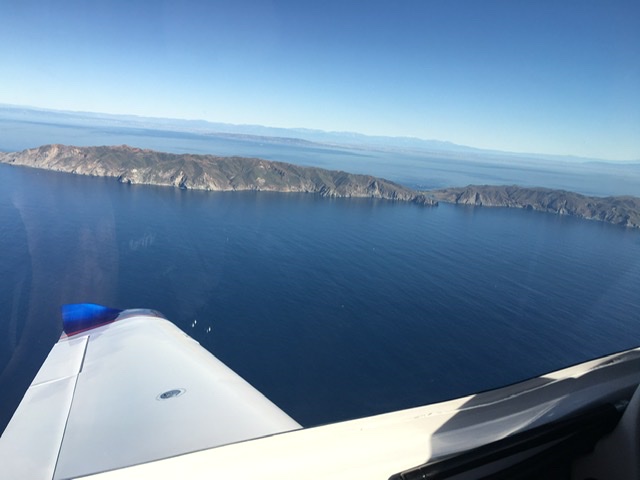-
Posts
41 -
Joined
-
Last visited
Content Type
Profiles
Forums
Gallery
Downloads
Blogs
Events
Store
Aircraft
Resources
Tutorials
Articles
Classifieds
Movies
Books
Community Map
Quizzes
Videos Directory
Posts posted by Mhalc
-
-
The first 2 test flights of a supercharged Jabiru 3300 (Gen4) are complete. Still several issues to work thru but in general the overall performance is working out to be with in 5% of the design targets. With modest boost levels (32 inHg) @ 5000’ DA my Lightning cruised at 171 mph (up from 145 mph). The fuel consumption increased ~ 1 gph, which is consistent with its normal 25 mpg running normally aspirated. In addition the takeoff run and climb performance improved by ~20%. These are very preliminary numbers and more test flights will zero in on the final performance levels.
The next series of tests will be conducted with higher fuel pressures, allowing higher boost levels. I plan to limit the total boost levels to 36 inHg which should yield 180-187 mph between 5,000’ and 12,000’ DA.
https://newtube.app/user/N530MH/91LQNga
-
 1
1
-
 1
1
-
-
That would be true where if the supercharged engine was operated as a “normalizer” where boost pressure was regulated to 30 inHg (which is an option for this system). Otherwise boosting an engine increases its effective CR which develops higher BMEP/IMEP, hence the concern for piston/wrist pin wear.
Yes, heat is a concern. As for my gen4 3300, the first 150 hrs have demonstrated its ability to run cool and shed heat nicely. Burning more fuel generating more power will surely increase the heat as will the compressors inlet air temp. With the TBI and Jabiru’s fixed timing the only protection I have against “knock” is the boost controllers monitoring of the inlet air temp’s and reducing/eliminating boost if I get any where near the knock limit. In addition I only use 100LL fuel which will also help control “knock”.
For simplicity and based on ground testing only, I have not install an intercooler but have provisions for installing one if needed. I know I am leaving some HP (and increasing heat) on the table by not installing one now, so I’ll see how flight testing goes.
-
The goal here is not gobs of HP, but altitude performance. Keeping a modest HP increase (14%-20% at SL) through a wide altitude range. In my case I routinely fly between 9,000’-13,000’ DA. The modest HP increase and critical altitude of ~16,000’ DA I hope to see a 25-30kts increase in cruse speed (flight tests this month will tell!).
-
 1
1
-
 1
1
-
-
The test stand engine is an early Gen2 and I monitored through bolt and head bolt torque for the duration of the ground testing. Neither exhibited any change during the test cycle.
BMEP increased by ~18% at the tested boost levels, I am more concerned with piston/wrist pin wear. I expect the overall life expectancy will be reduced (as with any performance modification) and plan top end inspections as I transition from flight test to general use. I’ll need to accumulate some real world hours before I really know the impact.
To answer your specific question, I did not calculate force caused by an increased BMEP/IMEP as it translates from the crank->cases->through bolts. But was and will be monitored during the remaining test phases.
-
I have completed testing on the test stand of a supercharged Jabiru 3300. The tests were conducted with a Bing 94/40 carburetor and Rotec mkII 40mm TBI. With a modified fuel system the Bing operated well with manifold pressures to 36 inHg generating ~137HP. With the TBI the engine operated well with manifold pressures to 38 inHg.
I have started installation on my aircraft (Gen4 3300, with new pistons as part of a Jabiru recall). Ground testing should start in a week or so, and when all checked out, flight testing. Short term goals are to identify practical operating manifold pressures (target is 40” MAP takeoff power and 34-38” cruise), validate boost control computer software (SL thru 16,000’ DA), and aircraft performance.
A short video of the last ground test with the boost control computer configured for boost pressures of 3psi/36”MAP
-
 1
1
-
-
8 hours ago, facthunter said:
Have you got a backfire relief valve in the system? Nev.
There is not a separate backfire relief valve.
The design is “draw-thru” so the Blow-Off-Valve (BOV) vents the boost overboard unlike a “blow-thru” which would have a fuel/air mixture and needs to be recirculated before the blower to prevent compressor stalls during rapid deceleration. In addition the BOV remains open until takeoff/climb/cruise power settings are selected.
-
 1
1
-
-
So far the test stand testing is progressing well. The current configuration is an old Jabiru 3300 (SN 966) and Bing 94/40 carburetor. The supercharger is ROTREX C15-60 with a custom drive/mount assembly with a electrically controllable BOV to regulate the boost level.
Current boosted output is in the 140HP range, which will be available thru ~10,000DA and 120HP thru ~16,000’DA.
The next series of tests will be with the Rotec 40mm TBI, followed by ground and flight testing in a Jabiru powered (Gen4 3300) Lightning.
https://newtube.app/user/N530MH/tbt4GD6
-
 1
1
-
-
Yes the TBI has traditional mixture control and less sensitive to fuel pressure. In the stock configuration, I have been using a HACman for mixture control with the Bing. I fly regularly between 8,500’ and 12,500’ and the HACman performed well. Still need to test the HACman in the supercharged configuration.
-
For my application (Gen4 3300) I have a 40mm TBI, but I have been approached for Gen2/Gen3 options as well. So I have been working out suitable fuel systems for the Bing. For the Bing, you need a higher pressure fuel pump, and boost referenced pressure regulator. As the float needs (4psi + boost pressure) fuel pressure to operate. Your are correct it has taken longer than I expected to get here, but I am starting to get good results and integration is progressing well. I hope to have test flights in and fly to Sun-N-Fun this year.
-
I have completed the first series of ground tests (test stand) of a supercharged 3300. These tests were conducted using a Bing carby, at manifold pressures to 34”MAP (just slightly higher than a normalized engine). Future tests (after the first of the year) will be used to identify a practical maximum for the Bing (which may turnout to be 34”MAP). Followed by a series of tests using the Rotec 40mm TBI, with the expectations the TBI will handle higher manifold pressures.
-
 2
2
-
-
Having a "blower" downstream of a carb helps to distribute the fuel mix more evenly. You are adiabatically heating the induction air and loading the engine to drive the blower as well. Most decent sized Radials have blowers many of which are variable speed driven for higher altitudes. More power from the engine the more heat it has to disperse. A Water Methanol injection for the TO power may help. It will probably reduce carbon build up as well. I once owned a Twin Commanche that was factory fitted with Turbochargers as it regularly operated over the Rockies near the Canadian border in the west . Even though it only restored ground Sea Level performance at height the whole motor was beefed up from the "normal" engines. fitted. Nev
In my case the carb/TBI is downstream of the supercharger, and between the SC and carb/TBI is an electrically controllable blow-off-valve (BOV). A small computer (boost controller) controls the position of the BOV to regulate the boost levels into the carb/TBI. The user can configure the boost level from 30” to 42” of MAP (testing will establish the practical maximum). So one options would be to operate the SC as a “normalized” engine with SL HP to ~16,000’ or boosted power to ~10,000 then dropping back to SL HP at ~16,000’.
-
If going down the blown engine route you will need to entertain the idea of fuel injection. That bing simply won't do the job. Then of course you will have excess heat to take care of. Your electrical system will have to reflect the changes, Rotec make an alternator mount and pulley for the jab. I wish you well on your endeavour.
As for the fuel injection/electronic ignition I wanted to preserve the Jabiru’s traditional aircraft engine approach with fixed timing simplified fuel delivery. I do have an AeroCarb and Rotec TBI which I plan to test with in addition to the Bing. The AeroCarb being only 35mm will be the least likely to keep up with the ~220CFM boosted flow rate, but the Rotec and Bing being 40mm should be fine at this modest boost rate. The boost control computer and electrically controllable boost regulator valve require less than 2A’s, that combined with my current power load, keeps the total well below 20A’s, not sure why I need a bigger alternator. As for heat, flight tests will tell the tail, but my gen 4 is running well below the continuous limits now and thermodynamic calculations keep me below these limits as well as well below the knock limit.
The devil is in the details, but the proof is in the TESTING :).
-
 1
1
-
-
Wow Mhalc, this might be the first supercharged Jabiru. It sure will be interesting to see how it goes. Good luck with the project.
I know of a guy who daydreamed of just such a thing when he was at 14,500 ft and his Jabiru ran out of puff.
Thanks for the well-wishes. As an engineer I know the devil is in the details, BUT the proof is in the testing. Where I fly in the southwest US I climb to 9,000’ or more to go on any x-country to get over the mountains.
-
I dimly remember a videoclip from the US of a bloke installing a turbo on his 3300 Jab engine.
I tossed around the turbo idea for my Gen 4 3300, but the exhaust heat added under the cowling and exhaust back pressure/heat on the valvetrain lost out to the simpler supercharger. I did add a twist, an electrically controllable blow-off-valve and small controller to provide variable (user defined) boost profiles. Very much like a turbo-normalized engine without the excess hear under the bonnet.
-
Be very aware of the weight of the new prop Mhalc.
In addition to the weight of the CS prop, I am adding an additional 9.5lbs to the back of my Gen 4 3300. I have worked out the design, and started fabrication of a supercharger mount and drive assembly. I hope to complete the mount/drive assembly and start testing on a test stand in the next few weeks.
-
 1
1
-
-
Bruce, You have given me something else to be worried about! :)
-
kgwilson, I have never had a starter motor cause a fire type problem either, but when I asked a guy who was once an auto-electrician, he said that it sure did happen. At the time, I was worrying about what would happen if the solenoid welded itself on. The engine would be running at idle but making enough noise to mask the sounds of distress coming from the starter system.
One solution is to use 2 solenoids in series but I didn't like the idea of the extra weight. My compromise was to put a red light on the instrument panel which indicated if power is applied to the starter . The idea being that if this red light stays on when the starter button is released then it would be a good idea to close off the fuel and the mags. The engine would continue to crank without firing until the battery was depleted.
I hope this never happens.
I like the indicator idea! I’ll have mine apart in a few weeks for it first 100hr inspection, getting the parts together for the indicator idea. I did weigh my spare solenoid, your’s must be much heavier than mine.
-
Be very aware of the weight of the new prop Mhalc.
I did rework the W&B sheet for the additional weight. But I am looking to take advantage of other changes I am making under the cowlings.
-
Thanks for the input, it looks promising! I had an Airmaster prop on order for 4 months, but I fell like the ”customer time forgot”, need to get other options lined up.
-
I have been searching around for constant speed propeller options for a Jabiru 3300. Are there any other options beside Airmaster?
-
Yes I fully understand pressure drops with increasing altitude. If we look at the 55% power, 100hp at 2400rpm column, (#33) ar sea level 19.3in of manifold pressure is required. We climb to 10,000 feet, the rpm is same 2400, the prop has increased pitch in the less dense air and the engine is still producing 100hp and the same torque but now only 17.2in of manifold pressure is required. Why?
Which fuel flow gauge (or system) did you use?
I have a GRT avionics system, EIS and EFIS. The EIS has a “Red Cube” fuel flow sensor attached and measures fuel flow and totalizes usage. I did take a bit of effort to get the calibration right, but I find it to be very accurate, much more so than the fuel tank gauges :).
-
That’s what a constant speed prop does. It varies the pitch of the prop to maintain a set rpm. If the engine is losing power it will fine up the pitch to maintain rpm
I’ll track down the report you recommend, sounds interesting. It is true the prop pitch will “fine up”, but to maintain RPM the engine will still need to pump an amount of air equal to 1/2 its displacement times the RPM (for 4 cycle engines). If the fuel air ratio drops below the minimum stoichiometric ratio the engine will be so lean as to quit.
-
The only cautionary comment I’ve had was from a LAME who warned to keep a spare set of carbon brushes handy as they do wear down in service. Apart from that, the quality of mine is superb and all ground testing has been perfect. I checked blade tracking yesterday and the total difference is less than a quarter of a millimeter or less - too small to even measure accurately unless I wanted to use a dial gauge.
You MUST fit a MAP gauge AND a fuel flow gauge. The first is required by Rotax because you CAN overload the engine if the prop is mishandled. SL - 912 -016R1 section 3.1.3 refers.
The second is a matter of safety. It is possible to have an engine producing takeoff rpm and correct MAP but producing SFA power if fuel flow is restricted. You must see correct fuel flow and MAP to assure required power.
Sounds great, I just wish I could see for myself. Still no definitive ship date, and the window Airmaster provided is quickly passing :(.
When I built my Lightning I included MAP and fuel flow gauges, but I think for the Jabiru all I would need is the MAP sensor.
Good tip on the carbon brushes for the slip ring.
-







Jab engines
in Engines and Props
Posted
I thought I would post some updates to my supercharger project. I have changed the drive section from a 2 x 25mm pulley/belt system to a single 50mm pulley/belt system. Much easier assembly and maintenance, so far much more reliable. The test flights have been at altitudes between 8000’-10000’ (DA) at 2900-3000 RPM. With the boost controller set to provide 32 - 36 inHg MAP.
In this range my Lightning is cruising at 178 mph (up from 147). Increasing the boost above 36 inHg does produce more (HP) and speed but the speed increment is smaller for each increase above 36 inHg. (Still noodling on that one).
BTW the CHT/Oil temps have increased slightly on my gen4, but well within the green.
If interested more details can be viewed at: <N530mh.tumblr.com>